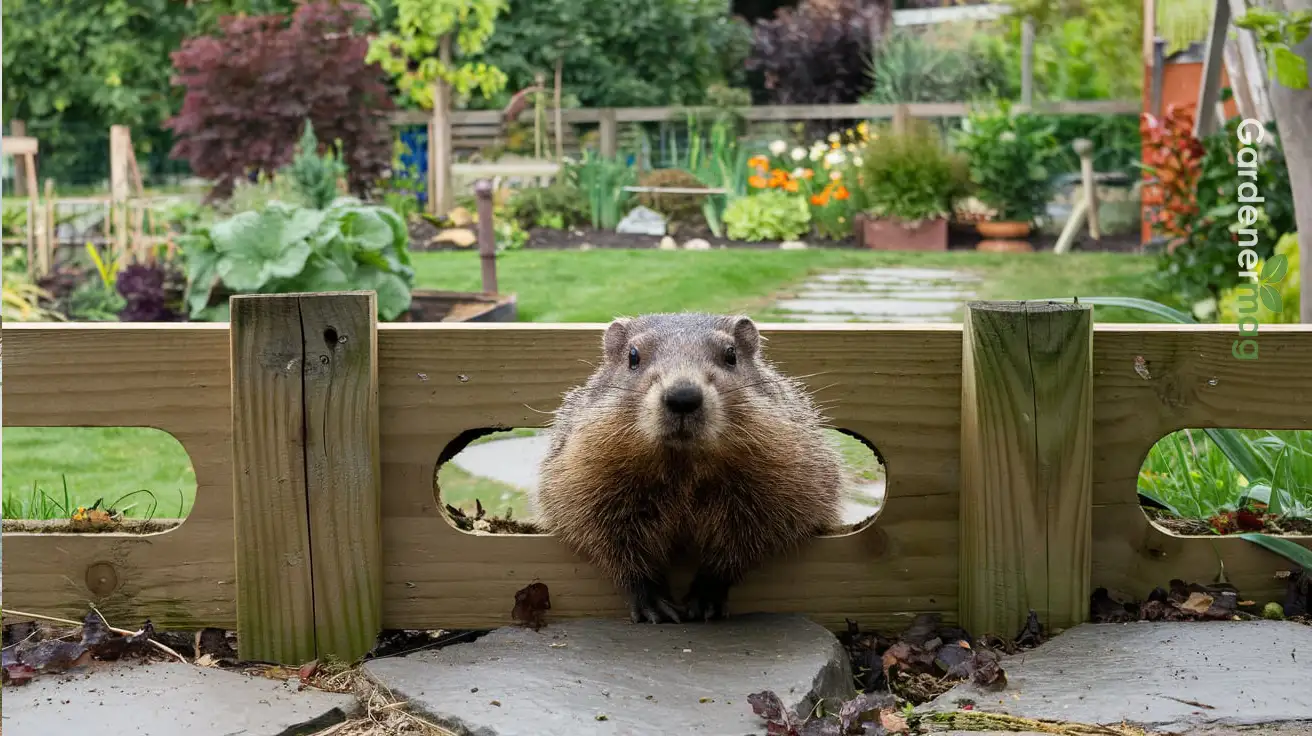Are you plagued by groundhogs constantly eating your plants and looking for effective ways to keep them out of your garden? This guide is for you!
Groundhog is a nuisance. It consumes grasses, clover, leaves, twigs, peas, cucumber, beans, herbs, lettuce, impatiens, pansies, strawberries, and so on, causing damage to your garden plants, vegetables, and fruits.
Luckily, there are easy but effective ways to get rid of these critters. Read on for some simple and all-natural methods to keep groundhogs away and make your garden safe.
Signs That Your Garden Is Under A Groundhog Infestation

Groundhogs, also called whistle pigs or woodchucks, are herbivores – they eat solely plants. They spend spring and summer eating so they can survive winter hibernation.
They are like an an overgrown squirrel and can grow up to about 16 to 20 inches long and weigh up to 5 to 10 pounds. They are primarily brownish-gray in colour, and have a dark, furry tail that is four to seven inches long.
Groundhogs have large front claws well-adapted for digging. With their claws, they can excavate burrows with multiple exits.
These animals are swift and can quickly retreat to their underground hideout when they sense danger. This makes it tricky to get rid of groundhogs.
However, groundhogs are not the only mammals that can damage your garden. Raccoons are also mischievous animals that can wreak havoc on your garden.
So, what are the signs that you have groundhogs in your garden?
The first sign that you have groundhogs in your garden is disappearing fruits or vegetables. Once you start noticing that your plants or vegetables are disappearing, know that groundhogs have set up their housekeeping in your garden.
Note that groundhog won’t just eat one plant or fruit, it will gulp down several plants or fruits.
Another sign is a burrow of about 10 to 12 inches wide, with heaps of dirt around it to mark the entrance. The burrow may be along the edges of a shrub row in your raised garden bed or open ground or under a structure like a shed, deck, or wood pile.
Other signs include claw marks, bite marks, or chew marks on your garden plants.
Ways To Get Rid Of Groundhogs In Your Vegetable Garden?

Try some of these natural methods to protect your plants and keep woodchuck out of your garden:
Frighten them with noise
Groundhogs are shy mammals and can be easily frightened by noise. You can use any noisy moving item to scare groundhogs.

For instance, you can install brightly-colored pinwheels, wind chimes, dangling CDs, or any other shiny garden decorative items that make noise to put off groundhogs.
You can also scare these pesky mammals with balloons. Attach mylar balloons around your garden and at the entrance of their burrows.
Also, groundhogs dislike anything that distracts them. So, you can scare them from your garden using motion-activated water sprinklers.
Please note that motion-activated water sprinklers don’t only target groundhogs but anything that moves. To avoid sprinkling yourself or others in the vicinity, position the device effectively around your garden.
Fence them out of your garden

Whether you have a raised garden, an in-ground garden, or are practicing container gardening, you can stop groundhogs using a fence.
Build a fence with chicken wire around your garden plants to protect them. This is the best method to keep those annoying mammals away.
Keep in mind that groundhogs can burrow their way through under the fence and can also jump over short ones.
Hence, for a fence to be effective, it must be at least 3 feet high to prevent groundhogs from jumping over. Bend the top 10-15 inches of the fence outwards away from the garden at a 45° angle. This will prevent groundhogs from climbing over it.
Also, bury about 12 inches of the fence into the ground with about 6 inches bent outward from the garden. This will prevent the groundhog from digging under the fence.
If available, add an electric wire 4-5 inches off the ground and 4-5 inches away from the fence for added security.
Deter them with repellents

There are some natural repellents that stop groundhogs. These natural repellents contain ingredients that irritate groundhogs. They include garlic, castor oil, red pepper, Cayenne pepper, lime, and Talcum powder.
Spray some castor oil on your plants to make them taste awful to groundhogs. You should also spray some around your garden, especially near the entrance of the groundhogs’ burrows.
Crush some garlic and pepper, and sprinkle them in the groundhogs’ tunnels, also sprinkle some around your garden. You may even add water to the mixture and spray it on your plants.
You can sprinkle some grounded Cayenne pepper on the plants or around their base to prevent groundhogs.
Spreading some lime around your garden or near the entrance of their holes can scare them as it will burn their feet when they walk on it.
The effect it will have on groundhogs if they touch, eat, or smell it will definitely deter them from coming back.
Cat litter, pet fur, and human hair can also stop groundhogs from your garden. If you have a cat or dog as a pet, you can let it run around in your garden, spreading its fur, smell, and urine, which can really deter groundhog.
Besides, groundhogs see dogs and cats as predators, so having them running around in your garden will scare off groundhogs.
Trap them

You can use a live trap to catch the groundhogs. Once you catch any groundhog, transport it about 5 to 10 miles away from your garden. You should also check your local law to know what to do with a groundhog once you catch it.
Keep your garden tidy
Finally, make sure that your garden is always tidy. Remove any dirt heap or compost piles from your garden yard, and remove weeds underneath shrubs. Also, prune short shrubs regularly.
Conclusion
Keeping groundhog out of your yard or garden can be a challenging task. However, there are easy and effective ways to get rid of groundhogs in your garden.
By trying any or all of the methods above, you can create an uncomfortable, unappealing environment for groundhog and eventually get it out of your garden.
Although it may take some time to get groundhog out of your garden completely, we advise you to be patient and persistent.
Frequently Asked Questions (FAQs)
While groundhogs are herbivores, they do not eat all herbs or plants. Groundhog will not eat garlic, onions, potatoes, and beets. It also dislike wormwood (Artemisia), thyme, chives, lemon balm, lavender, and fennel.
Generally, groundhogs are not dangerous, but they tend to pose a threat when they feel threatened. On rare occasions, groundhogs may carry rabies, which means that you have to be wary of their bite.
Although having groundhogs around in your garden helps to aerate the soil and mix the soil, the damage these cause outweighs the benefits.






